How Do I Find Water On My Land
one) What is involved ?
Searching for water located below the earth's surface, in phreatic layers or aquifers, in order to pump it. This is washed with the utmost care and precision, using appropriate techniques, in order to dig or drill wells in the best possible places and thereby avoid costly, discouraging failures.
ii) Who employ this means and since when ?
Around 1250 BC, Moses searched for h2o in the Sinai desert using his divining rod, practicing an art known since early on Antiquity. However, the modernistic techniques stem from the 20th century.
This method is mainly used in developing countries or other regions where water is rare and where irrigation is essential for crops. It is as well used in developed countries but mainly for uses other than straight consumption (gardening, geothermal energy).
3) Why ?
Given the growing and vital importance of h2o and soil resources around the world, as well as their scarcity, we need to do everything possible to improve the finding, management and preservation of these essential and fragile resource.
Groundwater is usually good-quality h2o. As it is often cached at pregnant depths, it is highly advisable to locate it as precisely every bit possible and assess its quantity and quality before undertaking plush drilling work and thus avoid costly failures.
This water can be detected with more or less precision depending on the methods used, through the electromagnetic waves information technology emits.
4) Who is primarily concerned ? Places or contexts in which this method seems nigh advisable
This method primarily concerns underprivileged rural or peri-urban areas. In mountain areas, this method is difficult to implement due to the keen depths involved.
Information technology particularly concerns regions prone to astringent droughts. Indeed, aquifers are natural cloak-and-dagger reservoirs capable of supplying large quantities of drinking h2o during the dry season, when rivers are likely to dry up.
5) What does this process involve ? How is it implemented ?
In bodily fact, it consists of different methods ranging from the near rudimentary – but nevertheless of interest for people or small communities with little means, such as dowsing – to the nigh sophisticated such as the prior assay of satellite photos or proton magnetic resonance (PMR) investigations.
The purpose of this certificate is not to give detailed explanations of the mode of operation and utilise of the various techniques, as about of them are fairly plush and can only be used by specialists. Instead, it aims to explain the principle and main advantages and drawbacks of the techniques, and so that the communities and people concerned can discover out about their main characteristics and exist able to contact specialised companies, having gained better noesis of the facts.
The search for groundwater sources must take account of technical (hydrogeological) criteria equally well as socio-economical criteria (closeness to a hamlet, cost of investigation). In actual fact, closeness to the beneficiaries often remains the prime criterion.
There are diverse methods for investigating phreatic layers. Traditionally, dowsing was the only way of searching for groundwater. Subsequently, more than modern and scientific techniques were developed, significantly improving the success charge per unit of h2o collection facilities.
a) Preliminary survey
Information technology is highly appropriate for phreatic layer investigators, especially if they are not from the region concerned, to carry out preliminary surveys in order to collect information which can give them precious data on the places where there is a likelihood of finding h2o.
Depending on the size of the expected source, this can consist of either :
- after a first look at the site and a meeting with the chiefs or heads of the villages, a survey with their population to find out where wells would have been dug or where springs would have been used, where the vegetation is greenest and remains green during the dry out season, where trees and plants naturally grow best, where the existing water sources have the highest outflow in all seasons, where the termite mounds are located, if any, etc.
- or, at the same fourth dimension, research into the region'south geological map, climatic data and all advisable information which may exist obtained from the local or regional authorities or other organisations or operators working in the region.
b) Dowsing
In numerous countries (including France), certain people have the power to investigate and determine the presence of h2o on a site and detect water channels (veins, faults and aquifers).
These "dowsers" are often people who have special abilities passed down by their predecessors or a village wise man or woman.
The principle consists in :

Utilise of a forked twig past a dowser in
Burkina Faso - Photo Sogreah
- Choosing a forked or Y-shaped twig from a tree such as a mango tree or using metal rods
- Positioning the twig or rods between the fingers and then every bit to amplify the sensations felt and seeing if they twitch and go down (or cross) at the expected place.
- Criss-crossing the area in guild to determine the most promising areas.
 At that place are different types of divining rods :
At that place are different types of divining rods :
- The Y-shaped or 5-shaped twig
- Metal rods
- Parallel rods
- The Hartmann lobe
- The Lecher antenna
When the dowser uses metal rods, he holds them parallel between his fingers. When he comes close to a place under which there is h2o, the rods become closer together and terminate upward crossing over ane some other where a groundwater source is pregnant. This can be tested and proves successful with many people, merely the findings are imprecise and practice not indicate the size of the aquifer.
Moreover, this method doesn't make it possible to observe small-scale, relatively deep groundwater flows.
c) Modern methods
These methods make it possible to locate aquifers with more than precision, and they are much more efficient in assessing their size, book, quality and sustainability.
Topography
Analysing maps and local vegetation gives a beginning indication of the presence of water. In the instance of large-scale investigations, a global geological assay can fifty-fifty be carried out through the interpretation of satellite images or aerial photos. These can highlight the presence of the major geological outlines liable to requite rise to fractures with an identifiable management or outcrops.
Hydrogeophysics
Geophysical methods are now the primary methods of investigation and detection of underground aquifers. The method chosen mainly depends on the geological context.
Traditional geophysical methods
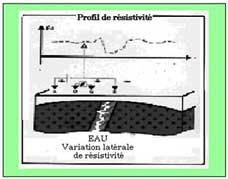
http://fodder.puit.sourcier.pagesperso-orangish.fr 
With these methods, we strive to written report the soil'south physical properties and in particular its electric properties. The aquifers are almost often trapped between rock layers. All rocks comport a sure amount of electricity, only their conductivity and resistivity vary according to their type : compact rock, dry rock, fractured rock, moisture rock, permeable structures or impermeable ones.
A material'south electrical resistivity is its capacity to oppose the flow of electric current.
These methods are thus based on the capacity of the soil or rock to conduct electricity and the measurement of their conductivity or resistivity (the opposite of conductivity).
From these measurements, the type, size and quality of the aquifer is deduced and specified, or perhaps but presumed, but with a loftier probability.
There are two main types of methods, which are sometimes used successively :
a) The measurement of electrical resistivity using direct electric current.
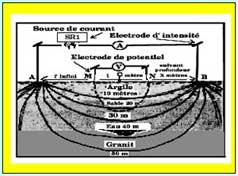
http://forage.puit.sourcier.pagespe... 
This is the most widely used method as it is suited to the greatest number of situations.
It consists in sending direct current into a geological structure on a given site (fifty to 400 volts depending on its resistivity - conductivity) using two electrodes (A and B).
There are several possible electrode arrays (Wenner, Schlumberger, 4 terminals, etc.).
The area investigated must not be besides large and must exist relatively flat and gratis of buildings which may cause interference and would make it impossible to take AB lines of the required length (over 300m).
b) Methods for measuring this reactivity by magnetic ways
Easier to implement, such as the Slingram and VLF methods, these methods measure out electromagnetic signals due to magnetic consecration phenomena. They don't need any contact with the ground and thus no electrodes. They get in possible to measure the soil'southward reactivity to electromagnetic excitation. Notwithstanding, they cannot be used on all types of grounds or for aquifers over xx metres deep, or even less. Their apply seems to have dwindled.
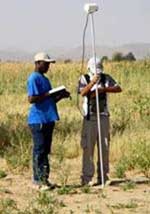
Search for water using the magnetic
resonance method in Tchad
Photo Iris Instrument
Proton Magnetic Resonance (PMR)
This is a direct water detection method. Information technology consists in sending electric currents into the footing, then measuring the signals emitted past the nuclei of hydrogen atoms in water molecules. It requires sophisticated equipment including proton magnetometers which can measure electromagnetic fields ; their recordings tin can be interpreted on site and, most importantly, the quantity of groundwater present in the rock tin can be deduced in a few seconds.
The isotope method
This method is mainly useful for tracing the water menstruation and to estimate the age of the groundwater. We know that the phreatic layer is renewed by the infiltration of h2o through the inflow area, where the aquifer'southward geological construction is exposed to the surface. Investigations using the isotope method can often give useful indications.
If there are infiltrations, they can exist detected and assessed by analysing the variations in the isotope content of the damp soil above the phreatic layer. The most used isotopes are tritium, deuterium, oxygen 18 and carbon 14. The results have shown that this method is reliable and promising, in particular if information technology is used with the physical models describing the h2o flow.
half dozen) Remarks - Precautions to be taken
- Dowsers can never guarantee the presence of water, nor its depth, quantity or quality, equally their approach is solely sensory. Moreover, it can be distorted by various factors (lack of concentration, presence of an electrical current). To optimise the investigation of aquifers, additional information and measurements are thus required.
- To avoid considerable risks, it is indispensable to telephone call on the services of hydrogeophysics experts for major drilling work.
Indeed, it is essential to have highly sophisticated equipment and to know how to maintain it, and to have solid knowledge and experience.
7) Option of the method according to the ground's hydrogeological characteristics
The possibilities are summarised in the tabular array beneath, taken from the AFD brochure and PS Eau, mentioned at the end of this document :
eight) Main advantages and drawbacks
a) Advantages
These methods sometimes avoid serious or costly errors in groundwater investigation and save both time and money.
Preliminary on-site surveys and dowsing provide interesting indications at a very low price when little means are available.
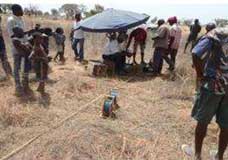
Search for an aquifer via a geophysical study in Namou
Kounlogue, Togo - Photo Cartas Togo
The methods based on electrical resistivity and conductivity are much more precise and offer corking spatial measurement density, which will allow relatively detailed exploration. They make information technology possible to detect indirect signs of the presence of water.
The PMR method is an innovative, rapid method for the direct detection of the presence of water. Its employ is expanding.
b) Drawbacks
About of the fourth dimension, operations based solely on a dowser's findings do non bear fruit or the findings are besides imprecise.
What's more, the effectiveness of a blazon of operation is difficult to assess since situations are rarely comparable.
Moreover, the use of this equipment presents drawbacks : it only allows detection down to a certain depth and the indications may be distorted by the presence of electromagnetic signals or electric lines.
Modern hydrogeophysics techniques are costly. They tin can only be used for the set-upward of large or numerous h2o extraction facilities for which large budgets are available.
9) Cost
Often, investigations for large aquifers in southern countries are financed through the United nations Development Plan and the World Banking concern. A preliminary survey must go far possible to assess the value of the information to exist obtained (i.eastward. their usefulness and cost).
While the price of a dowser is low (a few tens of euros), the price of using modernistic methods is much higher and depends on the situations encountered and the methods used. It always amounts to several tens of thousands of euros.
Dowsers' rates vary according to countries, the dowser's experience and travel expenses. For case, the dowsers of Dapaong in Togo accuse between €eighty and €160 for their services.
The cost of machines which have hydrogeophysical measurements depends on the size of the auto, maintenance costs and grooming costs. These costs are difficult to assess with precision as their is piffling information on the remuneration of aquifer investigation specialists, on the method(due south) they use and on the blazon of area studied.
Other costs include the transportation of equipment to the sites and accommodation and meals for the squad of technicians.
Information technology is generally accepted that the search for a drilling site should not exceed xx% of the toll of the drilling operation itself.
10) Achievement examples
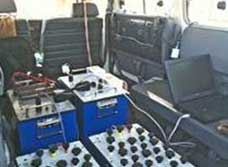
PMR instrument - Photo IRIS Instruments
In Chad, over 300,000 refugees from neighbouring countries have settled in the eastward of the country, where water was already in very short supply.
In lodge to find new water resource, several NGOs including OXFAM and UNHCR (Un Refugee Agency) have been working in partnership with Iris Instruments, a French company which manufactures equipment and provides training.
The principal method used has been that of magnetic resonance imaging : by sending electric currents into the footing, it makes it possible to discover hydrogen atoms and determine the quantity of water nowadays in the rock, provided the h2o is less than 150 g deep, which was the example in Chad.
Several aquifers were thus found around Iriba.
A complete magnetic resonance kit weighs around 350 Kg and costs most €140,000.
11) Where to obtain further information - Bibliography
a) Websites
- IRIS : 3-page article, "TCHAD_ Faire une radiographie du désert pour trouver de l'eau",
explaining the magnetic resonance method for finding water and how it was used in Chad (mentioned in item 9 as a good practice) :
Available online at : http://www.irinnews.org/fr/ReportFr...
- International Office for H2o : brings together the work documents (championship/author/state) focusing on water or sanitation research :
Available online at : http://www.oieau.fr/
- PS Eau-AFD : "Réalisation et gestion des forages équipés d'une pompe à motricité humaine en Afrique subsaharienne" vi pages (22 to 27) of this illustrated 86-folio brochure on drilling techniques and installations deal with the trouble of the search for h2o and positioning of h2o points. Bachelor online at :
http://world wide web.afd.fr/webdav/site/afd/s...
- International Atomic Energy Bureau website : The article presents the isotope method through the investigation of h2o resources in the desert :
Available at : http://www.iaea.org/
b) Video
Daily motion : Short video (2 min) on how to find a h2o source, showing how a dowser tin find groundwater using unproblematic rods.
Available online at : http://www.dailymotion.com/video/x4...
c) Bibliography
- Activity Contre la Faim : "Eau - Assainissement – Hygiène pour les populations à risques"
Comprehensive 745-page book published by Hermann 6 rue de la Sorbonne 75 006 Paris (€l) explaining and illustrating the various methods used by ACF to provide access to water and sanitation ; pages 131 to 173 focus on the search for aquifers, a topic which is well covered with detailed explanations and numerous examples and illustrations of the various existing methods.
- MARGAT, J. : "Les resource en eau. Conception, évaluation, cartographie, comptabilité."
146-page book published by FAO/BRGM, in the collection Manuels et Méthodes, n°28, Orléans, France. It explains the need to adopt a prospective approach in lodge to avoid water crises.
- CINAM (Cie d'études industrielles et d'aménagement-Montpellier) : training booklet for trainers "Le point d'eau au village" containing numerous factsheets on wells, pumps, hygiene, latrines also as 4 factsheets (ii.1 to 2.4) on the search for aquifers. Bachelor online at :
http://www.pseau.org/outils/ouvrage...
How Do I Find Water On My Land,
Source: https://wikiwater.fr/e9-methods-for-finding-underground
Posted by: hallashery1962.blogspot.com

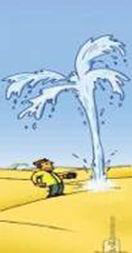
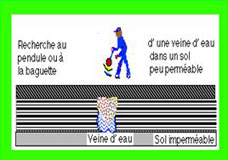

0 Response to "How Do I Find Water On My Land"
Post a Comment